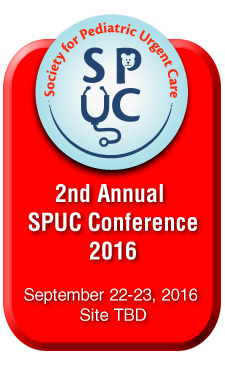SPUC Clinical Advisor
Your Clinical Questions - Answered
During a busy night at urgent care, there just isn’t time to do a literature review when you need an answer to your clinical question. The SPUC Clinical Advisor is just a few clicks away and has concise, Pediatric UC-specific guidelines for evaluating and treating a multitude of clinical scenarios. When should you be concerned about your patient with croup? Is irrigation ever contraindicated to remove an ear foreign body? What test has the highest negative predictive value when you are trying to rule out a septic joint? SPUC members have access to our growing list of Clinical Advisor topics. The answers to your clinical questions can be found at http://www.urgentcarepeds.org/clinical/.
Here’s a look at our Ear Foreign Body Clinical Advisor:
Ear Foreign Body
ALERTS
Button Batteries need immediate removal
Sharp objects such as glass can lacerate canal
Live insects can cause extreme discomfort
Food items absorb moisture which can lead to inflammation/infection
AGE
Typical age between 3 and 8 years
DIFFERENTIAL DIAGNOSIS
Cerumen impaction
Abrasion to ear canal
Otitis Externa
Tumor
EVALUATION
History
Patient may admit to placing something in ear
Parents witness placement
Symptoms of otalgia or otorrhea
Patient feels extreme discomfort in ear (insect)
PHYSICAL EXAM
Examine both ear canals for foreign bodies
Examine nares for foreign bodies
Look for live insect, any signs of infection or any bleeding
DIAGNOSTIC FINDINGS
Visualization of foreign body in ear canal
DIAGNOSTIC TESTS AND INTERPRETATION
Not necessary
MANAGEMENT
Removal
Young and uncooperative patients must be immobilized for successful removal.
All of these methods may push object deeper into canal.
-
Irrigation
-
warm water flushed into canal with 20 ml syringe attached to a flexible IV catheter tip contraindicated with TM perforation, food matter, or disc batteries
-
Instrumentation - best for objects in the lateral 1/3 of the canal
-
Alligator forceps or Hartman forceps - look for an edge to grab foreign body and withdraw
-
Ear Curette - visualize FB with otoscope, pass curette beyond FB and withdraw
-
Katz Extractor
-
insert catheter past FB, push on syringe to inflate small balloon and extract
-
Suction-usually not successful
Insect removal requires insect to be killed before removal with insertion of mineral oil drops into canal
Treatment
-
Patients who undergo uncomplicated removal do not need any follow up care
-
Antibiotic drops
-
Patients who sustained any abrasion or irritation of canal during removal procedure should receive antibiotic drops
-
Floxin Otic - 2 drops affected ear BID for 7 days
-
Surgery / Other Procedures
-
OR with sedation for difficult removals or uncooperative patient
ENT Referral
-
Outpatient
-
failure to remove
-
significant injury to canal
-
perforated TM
-
object is wedged in canal or against the TM
-
Immediate consult
-
Disc battery
-
Glass or sharp object
-
Liquefaction necrosis
Written instructions should include:
Anticipatory Guidance
-
Analgesics as necessary
-
PMD follow up in 2-3 days to asses for healing
Activity
-
No swimming or getting water into canal until ear is healed
Signs and symptoms indicating to return
-
Ear drainage
-
Worsening ear pain
REFERENCES
- Ansley JF, Cunningham MJ. Treatment of Aural Foreign Bodies in Children. Pediatrics 1998;101(4):638-640
- Fritz S, Kelen GD Foreign Bodies of the External Auditory Canal. Emerg Med Clin North Amer 1987;(5):183-192

